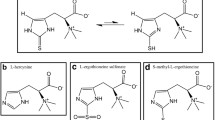Abstract
The activity of alanine aminotransferase (ALT; E.C. 2.6.1.2) is often changed upon inflammatory responses in animals. Rare earths was shown to provoke various inflammatory responses both in rats and mice; however, the molecular mechanism by which rare earths exert its toxicity has not been completely understood, especially, we know little about the mechanism of the interaction between CeCl3 and ALT. In this report, we investigated the mechanisms of CeCl3 on ALT activity in vivo and in vitro. Our results showed that Ce3+ could significantly activate ALT in vivo and in vitro; the kinetics constant (Km) and Vmax were 0.018 µM and 1,380 unit mg−1 protein min−1, respectively, at a low concentration of Ce3+, and 0.027 µM and 624 unit mg−1 protein min−1, respectively, at a high concentration of Ce3+. By UV absorption and fluorescence spectroscopy assays, the Ce3+ was determined to be directly bound to ALT; the binding site of Ce3+ to ALT was 1.72, and the binding constants of the binding site were 4.82 × 108 and 9.05 × 107 L mol−1. Based on the analysis of the circular dichroism spectra, it was concluded that the binding of Ce3+ altered the secondary structure of ALT, suggesting that the observed enhancement of ALT activity was caused by a subtle structural change in the active site through the formation of the complex with Ce3+.








Similar content being viewed by others
References
Shimada H, Nagano M, Funakoshi T, Kojima S (1996) Pulmonary toxicity of systemic terbium chloride in mice. J Toxicol Environ Health 48(1):81–92
Lu R, Ni JZ (2002) Mechanism of rare earth effect on liver. J Chin Rare Earth Soc 20(3):193–198
Ni JZ (2002) Bioinorganic chemistry of rare earths, 2nd edn. Sci, Beijing, pp 8–343
Zhu WF, Xu SQ, Zhang H, Shao PP, Wu DS, Yang WJ, Feng J (1996) Investigation on the intelligence quotient of children in the areas with high REE background (I)-REE bio-effects in the REE-high areas of southern Jiangxi province. Chin Sci Bull 41:1977–1981
Feng J, Zhang H, Zhu WF, Liu CQ, Xu SQ, Wu DS (2000) Bio-effect of rare earths in RE-high background Region I. Some blood biochemical indices from population resided in light REE district. J Rare Earths 18(4):356–358
Xia Q, Chen D, Liu YR, Chen AJ (2006) Effect of mixed rare earth oxide “Changle” on rat liver. Chin Rare Earths 27(3):76–78
Wu HF, Zhang XY, Liao PQ, Li ZF, Li WH, Li XJ, Wu YJ, Pei FK (2005) NMR spectroscopic-based metabonomic investigation on the acute biochemical effects induced by Ce(NO3)3 in rats. J Inorg Biochem 99:2151–2160
Feng JH, Li XJ, Pei FK, Chen X, Li SL, Nie YX (2002) 1H NMR analysis for metabolites in serum and urine from rats administrated chronically with La(NO3)3. Anal Biochem 301:1–7
Saier MH, Jenkins WT (1967) Alanine aminotransferase I: purification and properties. J Biol Chem 24(2):91–100
Reitman S, Frankel S (1957) A colorimetric method for the determination of serum glutamic oxalacetic acid and glutamie pyruvic transaminases. Amer J Clin Path 28:56–63
Perczel A, Park K, Fasman GD (1992) Analysis of the circular dichroism spectrum of proteins using the convex constraint algorithm: a practical guide. Anal Biochem 1992(203):83–89
Tu HM, Yang YS, Li Y, Wang ED (2000) Effect of rare earth ions on kinetic properties of Escherichia coli leucyl-tRNA synthetase. J Rare Earths 18(3):224–228
Zhao NM, Zhou HM (eds) (2003) Biophysics. Sci, Beijing, pp 278–276
Lakowicz JR (1983) Principles of fluorescence spectroscopy. Plenum, New York, p 258
Hong FS, Liu C, Zheng L, Wang XF, Wu K, Song WP, Lu SP, Tao Y, Zhao GW (2005) Formation of complexes of rubisco-rubisco activase from La3+, Ce3+ treatment spinach. Sci China, Ser. B 48(1):67–74
Liu C, Hong FS, Wu K, Ma HB, Zhang XG, Hong CJ, Wu C, Gao FQ, Yang F, Zheng L (2006) Mechanism of Nd3+ ion on increasing carboxylation activity of ribulose-1, 5- bisphosphate carboxylase/oxygenase of spinach. Biochem and Biophys Res Comm 342(1):36–43
Liu J, Ma LL, Yin ST, Hong FS (2008) Effects of Ce3+ on conformation and activity of superoxide dismutase. Biol Trace Element Res 125:170–178
Li N, Duan YM, Zhou M, Hong FS (2009) The effects of lanthanoid on the structure- function of lactate dehydrogenase from mice. Biol Trace Element Res. doi:10.1007/s12011-009-8448-0
Acknowledgments
This work was supported by the National Natural Science Foundation of China (grant no. 30901218) and by the Medical Development Foundation of Suzhou University (grant no. EE120701) and by the National Bringing New Ideas Foundation of Student of China (grant nos. 57315427 and 57315927).
Author information
Authors and Affiliations
Corresponding author
Rights and permissions
About this article
Cite this article
Li, N., Duan, Y., Liu, C. et al. The Mechanism of CeCl3 on the Activiation of Alanine Aminotransferase from Mice. Biol Trace Elem Res 136, 187–196 (2010). https://doi.org/10.1007/s12011-009-8529-0
Received:
Accepted:
Published:
Issue Date:
DOI: https://doi.org/10.1007/s12011-009-8529-0




